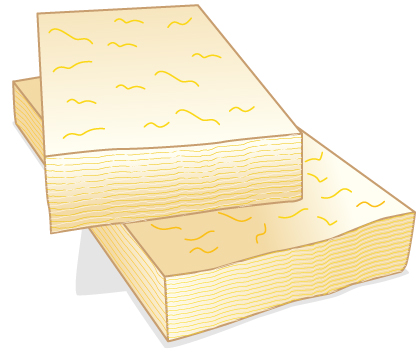| << Chapter < Page | Chapter >> Page > |
A combination of material and thickness is often manipulated to develop good insulators—the smaller the conductivity and the larger the thickness , the better. The ratio of will thus be large for a good insulator. The ratio is called the factor . The rate of conductive heat transfer is inversely proportional to . The larger the value of , the better the insulation. factors are most commonly quoted for household insulation, refrigerators, and the like—unfortunately, it is still in non-metric units of ft 2 ·°F·h/Btu, although the unit usually goes unstated (1 British thermal unit [Btu] is the amount of energy needed to change the temperature of 1.0 lb of water by 1.0 °F). A couple of representative values are an factor of 11 for 3.5-in-thick fiberglass batts (pieces) of insulation and an factor of 19 for 6.5-in-thick fiberglass batts. Walls are usually insulated with 3.5-in batts, while ceilings are usually insulated with 6.5-in batts. In cold climates, thicker batts may be used in ceilings and walls.

Note that in [link] , the best thermal conductors—silver, copper, gold, and aluminum—are also the best electrical conductors, again related to the density of free electrons in them. Cooking utensils are typically made from good conductors.
Water is boiling in an aluminum pan placed on an electrical element on a stovetop. The sauce pan has a bottom that is 0.800 cm thick and 14.0 cm in diameter. The boiling water is evaporating at the rate of 1.00 g/s. What is the temperature difference across (through) the bottom of the pan?
Strategy
Conduction through the aluminum is the primary method of heat transfer here, and so we use the equation for the rate of heat transfer and solve for the temperature difference .
Solution
The thickness of the pan, the area of the pan, , and the thermal conductivity,
Discussion
The value for the heat transfer is typical for an electric stove. This value gives a remarkably small temperature difference between the stove and the pan. Consider that the stove burner is red hot while the inside of the pan is nearly because of its contact with boiling water. This contact effectively cools the bottom of the pan in spite of its proximity to the very hot stove burner. Aluminum is such a good conductor that it only takes this small temperature difference to produce a heat transfer of 2.26 kW into the pan.

Notification Switch
Would you like to follow the 'College physics' conversation and receive update notifications?